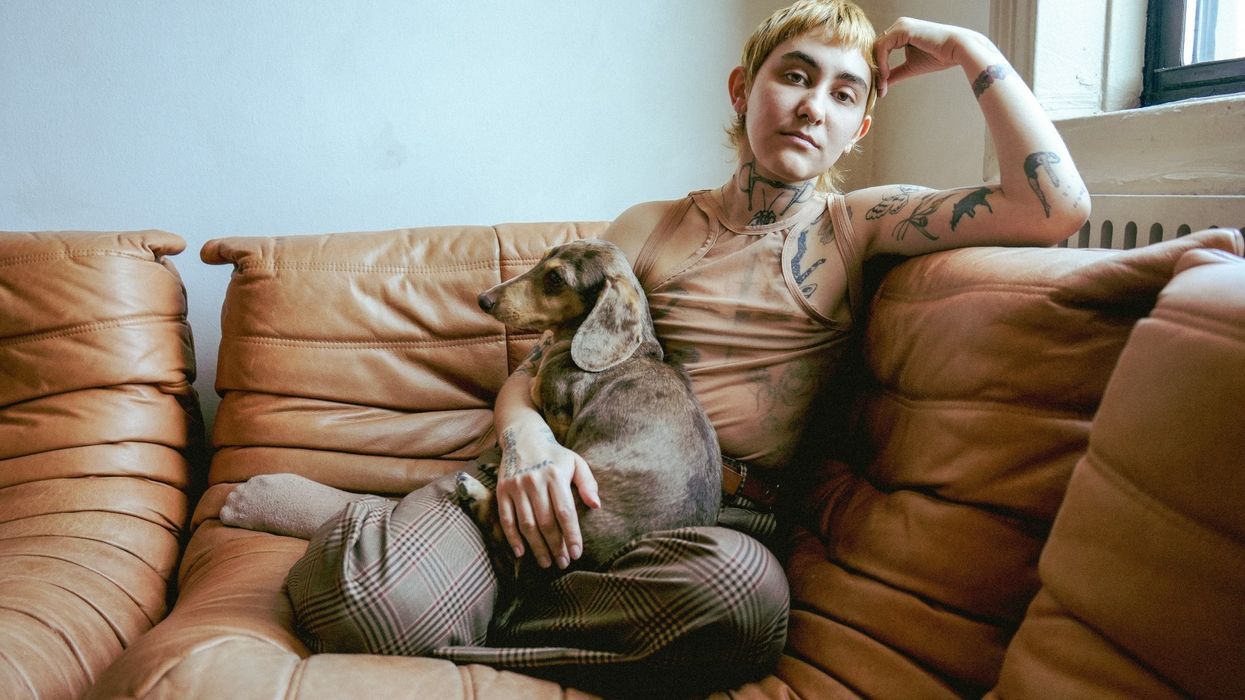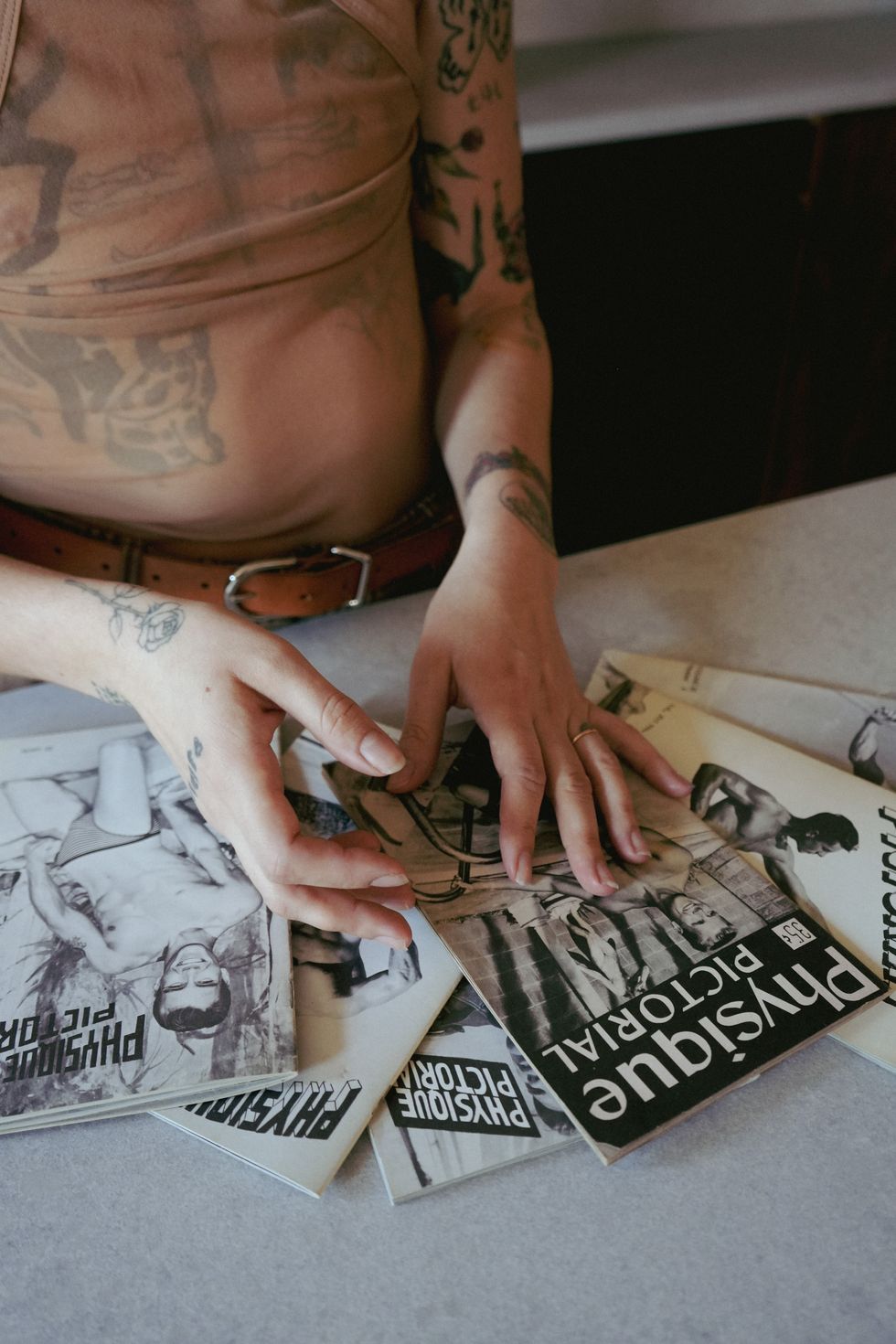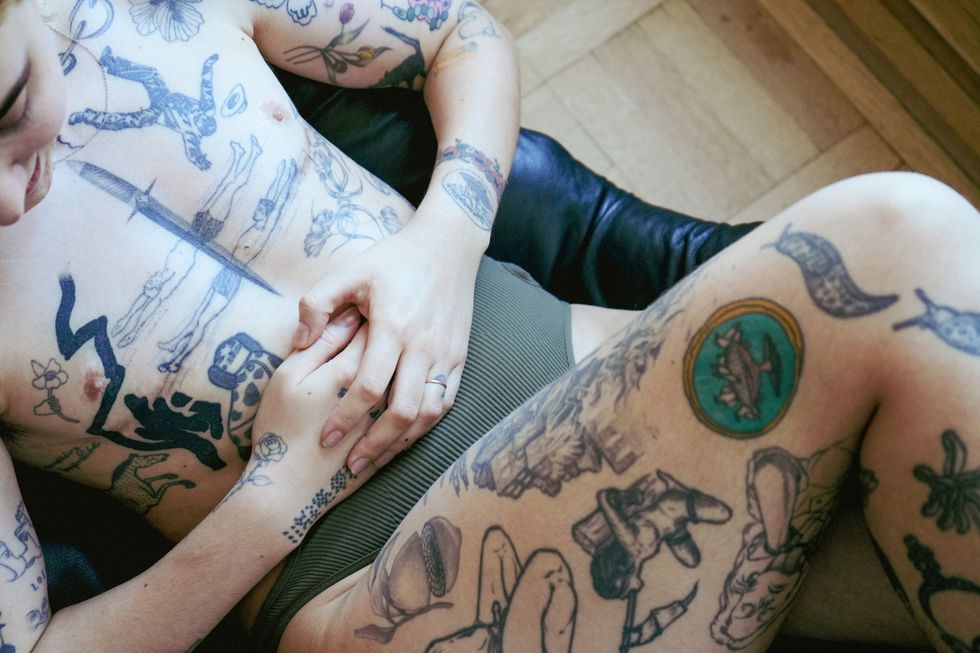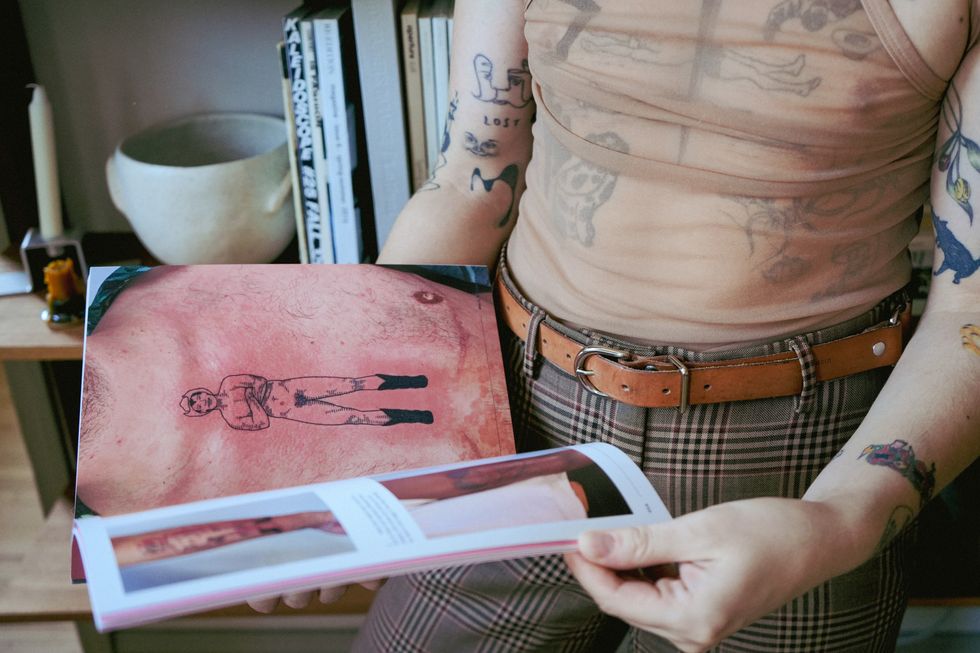Mars Hobrecker Doesn't Need Tattoos to be Meaningful
His own body features a massive backpiece he got on a whim and designs he says make his legs look "horny."

Mars Hobrecker would like to dispel the notion that every tattoo has to convey some grand deeper meaning. The silhouette of a horsebit crisscrosses his throat—this is the self-described horse girl’s current favorite tattoo. “The reason I love it is not really based on the meaning, which is, I mean, pretty trivial realistically,” he reflects. “I just think that is one where placement just feels so perfect.” Traced hands stamp the majority of his back, a piece he says he did “on a whim.” “I had seen in someone's flash [tattoo] and I was like, ‘Would you be down to do this on my whole back?’” Of the roughly 100 tattoos spanning the surface of the artist’s body, few secured premeditation.
The degree of mental preparation, in Hobrecker’s case, correlates inversely to his number of tattoos; the first one was a long time coming. “I was a queer kid who was going to an all-girls Catholic school and I had very little control over my appearance,” he explains. In those hallways, rules governed the minutiae of students’ self-expression. “I was really excited about the prospect of being able to get a tattoo because that was the first opportunity I had to make a choice for my body that couldn't be reversed by someone else.” After years of digging for the perfect symbol, he got “some very silly text on my ribs.”
Hobrecker slowly began to build his bodily art collection, but in a small way. In 2015, he threw his own pen in the ring. The trans artist began tattooing his friends and members of his immediate community. The landscape of the tattoo industry has changed a great deal since then. Now, private tattoo studios dominate the business. “I had such a large extended queer and trans community here who I think were expressing that they wanted to get tattoos or different body modifications for the same reasons, but didn't necessarily feel comfortable going to a lot of the traditional walk-in shop that you were what people viewed as the tattoo industry at that time,” Hobrecker explains.
Hobrecker began to develop a distinct sense of style the more he tattooed. His work places an emphasis on the human form and its imperfections. “A lot of the figures I pull [are] from old issues of Physique Pictorial, which is a gay nude-zine,” he explains. Unsurprisingly, cowboy hats are nearly as ubiquitous in the tattoos he creates as genitalia. His fan base grew in tandem with a new possibility: the ability to trade with other artists, a practice he values greatly. Today, Hobrecker’s body purposefully lacks the continuity of his own work. “For the type of work that I produce, I don't think I'm very versatile,” Hobrecker summarizes. “I really can only do the thing that I do. But I'm still inspired by so many different types of art, so on my own body, I just want as much difference as possible.” The majority are flash, which means he selected them during the appointment. The result? A mishmash of everything from his own trial-and-error experiments to butterflies to “straight up porn,” Hobrecker laughs. And the more he gets, the freer he gets with the decision process. “There's plenty that I don't like,” he reflects, “but none that I regret.”

Why did you just want to become a tattoo artist yourself in general?
“It really was something that I sort of fell into. I was initially just doing it for friends and friends of friends—my direct community. I started tattooing in 2015. That doesn't seem like that long ago, but the industry really did look pretty different at that point in time. I think the popularization of private studios hadn't really quite happened yet. Getting tattooed for me was so important for my own sense of self and my relationship with my body and just being able to self-actualize. I feel like I had such a large extended queer and trans community here who I think were expressing that they wanted to get tattoos or different body modifications for the same reasons, but didn't necessarily feel comfortable going to a lot of the traditional walk-in shop that you were what people viewed as the tattoo industry at that time. I was constantly hearing people talk about, ‘Oh, I really want a tattoo,’ ‘I really want to be able to do this for myself’ or ‘I'm feeling really dysphoric.’ People get tattooed for a lot of different reasons and there just weren't that many spaces that felt super comfortable. I was just finishing college and was like, ‘Well, if you want something really simple, I can probably figure it out.’ I didn't know how to draw at all—I was really, really bad at it. That was a time when triangle tattoos were really popular and I was like, ‘I mean, I can probably do a triangle. That's easy.’ So I really just started doing little things for friends, whatever folks asked for. I learned to draw at the same time that I learned how to tattoo just based on what people were requesting. People would be like, ‘I want a cat’ and I'd be like, ‘I guess I'll learn how to draw a cat.’ The cat didn't turn out great.”
What was the first one that was very visible?
“My first tattoo I put on my ribs with the intention of being able to hide it really easily. Then my next couple were on my arms, which definitely felt more visible, but they were upper-, inner-, or back-of-elbow. I could show them off if I wanted to, but they were still really, really easy to hide. It's funny, I actually don't have that much on my forearms. I guess the first, I'd say, were my hand tattoos. I got them maybe five years into being a tattooer and that felt, in a funny way, sort of a big deal still.”
As a tattooer yourself, is it interesting to see what people choose and how that compares to maybe how visible it will be in the place that they've chosen?
“Everyone has such different ideas around [tattoo visibility]. I have a lot of clients who want to be really conservative about placement or especially since I do a lot of tattoos that are sort of raunchy. But it's interesting to see. There are equal amounts of people who are saying, ‘I really want this, but I want to make sure it's somewhere really tucked away, so I can hide it if needed.’ And then an equal amount of people who are like, ‘Oh, this is raunchy. I want it to be front and center. I want to piss off my grandma.’”


How important is body placement in the decision process?
“You can have any design, but from a distance, people looking at it are going to pick up on the placement and the flow and how it is fitting with the body. I don't know, I feel like you can have the dumbest, silliest, little tattoo and if it's in a really, really good spot, I just think that that has such a bigger and more profound impact than the most technically precise, gorgeous tattoo that's just slapped randomly on the middle of the leg.”
As an artist, what’s it like tattooing yourself?
“Oh, I really hate tattooing myself. I think most tattooers hate tattooing themselves. It's awful. I've only ever really done it as part of the learning process. I do think that it's a really important part of the learning process when you are beginning to tattoo, just to have that sort of firsthand experience of how things feel as you're working. But I never wanted to tattoo myself.”
Tell me about the chronology element specifically of your own body. Do you want your tattoos to interact with each other? Do you want categorical groupings on different legs or arms or do you like all different types of things mixed in? Or do you even think about it?
“I definitely think about it. I mean, my body is a whole mess. When I started getting tattooed, I definitely wanted to be a tattooed person, but I wasn't expecting to have the amount of coverage that I do now. Also at that time, I was really into delicate, open line work pieces. I got a bunch of little tattoos that I placed really far apart from one another because I assumed that I was going to just have a few little, delicate, weird lines all over. As I started getting more and more, I now am dealing with having to fill in the weird gaps left behind. So I just put things wherever they'll fit. I think I really messed up with placement initially, but I'm at least glad that they're not in super visible places. I always tell clients, ‘Please for the love of God, do not get your first tattoo on your forearm. Don't do it.’ I think that's where a lot of people want to get their first tattoo because they want it to be super visible. The first is never the favorite, generally.”
How do you feel about trends in the tattoo world?
“I love tattoo trends. I think they’re so interesting. I love when you can look at someone's body and know exactly when in time the person got a certain tattoo. My oldest brother is covered in sort of neo-tribal work that he got either in the nineties or early 2000s. You would never assume that he got them at any other time. It's just so of that era and I think that that's so special. Some of the first tattoos I got are very early 2010s. I didn't get the mustache fingers tattoo, but I could have.”

The Favorite:
“I think the horse bit on my throat is my favorite right now. I mean, I was a horse girl. I rode horses for a long time when I was little. I thought it would be sort of funny to get this. It's the most and least hardcore tattoo simultaneously. It's like a bougie equestrian symbol, but dead-center on my throat. I think it has a sense of humor to it. The reason I love it is not really based on the meaning, which is, I mean, pretty trivial realistically. I just think that is one where placement just feels so perfect. The fit of that piece just works so perfectly with the shape of my throat. I was really nervous getting that tattoo, because even though I have hand tattoos and I'm pretty heavily tattooed in general, I think getting something really big across your neck is still a—I don't know, I did have a little bit of hesitation around it. Right after I got it, I just felt like the placement was so precise that it looked like it had been there forever. It just felt like it fit so perfectly. It felt so natural.”
The Biggest:
“My biggest is definitely my back piece. I have my whole back covered, but in a very open sort of cheating way. It's just massive, really heavy line work across my whole back. So it was definitely not my longest tattoo, but it was my biggest. Honestly, I had wanted a back piece, but had always been trying to decide what I wanted. It's such a large canvas. I wanted something pretty big there, but I don't know if I really wanted to go through the planning or work that would go into a more traditional back piece. This was an image I had seen in someone's flash and I was like, ‘Would you be down to do this on my whole back?’ It was really on a whim. It was absolutely horrible. I literally cried through it. It was hand poked, which is just like... Yeah, it was terrible—terribly painful process.”
The Smallest:
“I think my smallest is I have a little crescent moon on my ring finger and that was a matching tattoo that I got with an ex.”

The Most Daring:
“I feel like my legs are horny. On my right leg, the whole upper side and back is just straight up porn—ones where I'm like, ‘can I go to a beach with my in-laws now? I'm not sure.’ One specifically is a full color image of a bride sucking two dicks at once, but not the colors that you would expect. They're blue. It's intense. That was one I got and was like, ‘Oh my god, this is a lot.’ That one stands out as probably the most ridiculous tattoo I have.”
An Honorable Mention:
My first big tattoo is a piece on the center of my right thigh that was done by Noel'le Longhaul, who was really an icon to me. She was someone who I really, really looked up to and was I think sort of a pioneer of a certain DIY tattooing. It felt really cool for me to get a piece by her because she was just someone who I really admired for a long time. I got that piece right before I started tattooing. I feel like most tattooers think legs are where we just put the trash. It's where we practice and if you're doing a trade with another artist, I always feel like it's generally a little rude to ask for them to do a torso piece because it's just harder to tattoo. So usually if you're doing a trade, you'll just be like, ‘Oh yeah, just put it somewhere on my legs.’ That's why I have so many tattoos there.”
Tattoos Over Scars:
“I didn't really take my scars into account a whole lot when I started getting tattooed on my torso. I did wait a relatively long time before I put anything there because I was just really nervous about how that healing process would go. I probably waited about five years before I tattooed anything directly over my scars, but I definitely never had the intention of covering them in any way. I think, for a lot of people, that really does feel like a priority. They really want to get work that's going to hide their scars. But that was not really something that I ever really cared about. I just love the look of a really built out torso collection and I feel I'm just trying to use all the real estate I have available. Filling out my torso is a current priority for me, just because I think it looks really hot. There's no big trans scar feelings. It's like, ‘I just think this looks hot.’”




